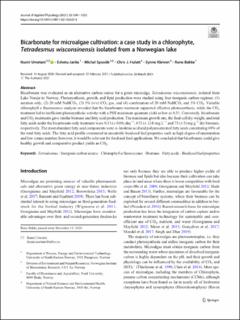| dc.contributor.author | Umetani, Ikumi | |
| dc.contributor.author | Wakjera, Eshetu Janka | |
| dc.contributor.author | Sposób, Michal | |
| dc.contributor.author | Hulatt, Christopher Jonathan | |
| dc.contributor.author | Kleiven, Synne | |
| dc.contributor.author | Bakke, Rune | |
| dc.date.accessioned | 2021-11-30T09:34:00Z | |
| dc.date.available | 2021-11-30T09:34:00Z | |
| dc.date.created | 2021-03-29T13:15:24Z | |
| dc.date.issued | 2021 | |
| dc.identifier.citation | Umetani, I., Wakjera, E. J., Sposób, M., Hulatt, C. J., Kleiven, S. & Bakke, R. (2021). Bicarbonate for microalgae cultivation: a case study in a chlorophyte, Tetradesmus wisconsinensis isolated from a Norwegian lake. Journal of Applied Phycology, 33(3). doi: | en_US |
| dc.identifier.issn | 1573-5176 | |
| dc.identifier.uri | https://hdl.handle.net/11250/2832028 | |
| dc.description.abstract | Bicarbonate was evaluated as an alternative carbon source for a green microalga, Tetradesmus wisconsinensis, isolated from Lake Norsjø in Norway. Photosynthesis, growth, and lipid production were studied using four inorganic carbon regimes: (1) aeration only, (2) 20 mM NaHCO3, (3) 5% (v/v) CO2 gas, and (4) combination of 20 mM NaHCO3 and 5% CO2. Variable chlorophyll a fluorescence analysis revealed that the bicarbonate treatment supported effective photosynthesis, while the CO2 treatment led to inefficient photosynthetic activity with a PSII maximum quantum yield as low as 0.31. Conversely, bicarbonate and CO2 treatments gave similar biomass and fatty acid production. The maximum growth rate, the final cell dry weight, and total fatty acids under the bicarbonate-only treatment were 0.33 (± 0.06) day−1, 673 (± 124) mg L−1 and 75 (± 5) mg g−1 dry biomass, respectively. The most abundant fatty acid components were α-linolenic acid and polyunsaturated fatty acids constituting 69% of the total fatty acids. The fatty acid profile eventuated in unsuitable biodiesel fuel properties such as high degree of unsaturation and low cetane number; however, it would be relevant for food and feed applications. We concluded that bicarbonate could give healthy growth and comparative product yields as CO2. | en_US |
| dc.language.iso | eng | en_US |
| dc.publisher | Springer | en_US |
| dc.rights | Navngivelse 4.0 Internasjonal | * |
| dc.rights.uri | http://creativecommons.org/licenses/by/4.0/deed.no | * |
| dc.title | Bicarbonate for microalgae cultivation : a case study in a chlorophyte, Tetradesmus wisconsinensis isolated from a Norwegian lake | en_US |
| dc.type | Peer reviewed | en_US |
| dc.type | Journal article | en_US |
| dc.description.version | publishedVersion | en_US |
| dc.rights.holder | © 2021 The Author(s) | en_US |
| dc.subject.nsi | VDP::Landbruks- og Fiskerifag: 900::Fiskerifag: 920 | en_US |
| dc.source.volume | 33 | en_US |
| dc.source.journal | Journal of Applied Phycology | en_US |
| dc.source.issue | 3 | en_US |
| dc.identifier.doi | 10.1007/s10811-021-02420-4 | |
| dc.identifier.cristin | 1901624 | |

